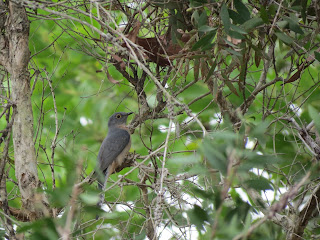LITTLE WATTLEBIRD Anthochaera chrysoptera
RED WATTLEBIRD Anthochaera carunculata
The genus Anthochaera contains the wattlebirds. 2 species of wattlebird live in the Melbourne area, both are very common and can be found in gardens, dry woodland and grassland. These are the little wattlebird and the red wattlebird.
SPINY-CHEEKED HONEYEATER Acanthagenys rufogularis
The genus Acanthagenys contains only one species, the spiny-cheeked honeyeater. Though uncommon in the Melbourne area this bird can be found in heathlands and saltmarsh, especially along the Mornington Peninsula. It can also be found in dry woodland in other parts of Victoria, but in Melbourne it is best seen in these coastal areas.
NOISY MINER Manorina melanocephala
BELL MINER Manorina melanophrys
The genus Manorina contains the miners. 2 species of miner live in the Melbourne area. The first, the noisy miner, is extremely common in dry woodland and grassland. The second, the bell miner, is also fairly common in dry woodland, but it forms small colonies in certain areas: examples include the Melbourne Zoo's carpark, and Merri Creek Park in Northcote. Both may visit gardens.
LEWIN'S HONEYEATER Meliphaga lewinii
The genus Meliphaga contains 4 species of honeyeater, 1 of which lives in the Melbourne area. This is the Lewin's honeyeater. It prefers riverine woodland and temperate rainforest. It is supposedly moderately common in the Melbourne area, but I have only seen it once there, in the forest around Healesville Sanctuary.
SINGING HONEYEATER Lichenostomus virescens
WHITE-PLUMED HONEYEATER Lichenostomus penicillatus
YELLOW-TUFTED HONEYEATER Lichenostomus melanops
The genus Lichenostomus contains many species of honeyeater, 5 of which (to my knowledge, there are probably more species I have missed) are regularly sighted in the Melbourne area. These are the yellow-faced honeyeater, singing honeyeater, white-eared honeyeater, yellow-tufted honeyeater and white-plumed honeyeater. Most of these birds can be found in dry woodland, though the white-eared honeyeater is known to prefer wetter forests. The white-plumed honeyeater can be found pretty much throughout the Melbourne area. The yellow-tufted honeyeater, on the other hand, is only found in a few select areas of mallee, though its endangered subspecies the helmeted honeyeater inhabits wetter forests near Melbourne.The genus Melithrepus contains only a few species of honeyeater, 2 of which (again to my knowledge) can be seen regularly in Melbourne and surrounds. These are the brown-headed honeyeater and white-naped honeyeater. The brown-headed is a bird of dry woodland, seen in places like Long Forest Conservation Reserve and the Cranbourne Botanic Gardens. The white-naped, on the other hand, prefers wetter forests. I have not had the experience of seeing either.
NEW HOLLAND HONEYEATER Philidonyris novaehollandiae
The genus Philidonyris again only contains a few species of honeyeater, only 2 of which inhabit the Melbourne area. These are the abundant New Holland honeyeater (seen pretty much everywhere from heathland to dry forest, including my garden) and the crescent honeyeater (a lot less common, it prefers wet forests and is a specialty of the Otways NP).
EASTERN SPINEBILL Acanthorhynchus tenuirostris
The genus Acanthorhynchus contains the 2 spinebills, of which only one inhabits Melbourne's forests, both wet and dry. This is the eastern spinebill, a locally common honeyeater in good forests, which I first saw in the Grampians area but have seen around Melbourne Zoo as well.
WHITE-FRONTED CHAT Epthianura albifrons
The genus Epthianura contains the 4 Australian chats, which are actually honeyeaters and not related to the chats of most of the Old World. Only one can be seen in Melbourne, and this is the white-fronted chat. It prefers saltmarsh and similar habitat near the sea, and is a regular sight at the Western Treatment Plant.Those are the common honeyeaters of the Melbourne area.


















































